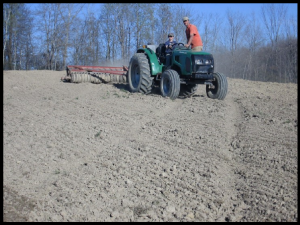 Download a PDF copy of this management sheet:
Download a PDF copy of this management sheet:
Hay - 10 Tips for Successful EstablishmentDownload PDF
- Prepare a firm seed bed – soil left too loose, especially in late spring and summer, combined with minimal rainfall allows the seed to germinate, but also to dry out quickly killing the seedling before it has enough root to survive.
- Plant grass seed no deeper than 1/2 inch – beware of drilling seed too deep, particularly when field moisture conditions vary or fields are uneven. A drill set correctly in the drier part of the field may go too deep in wetter parts of the field.
- Ensure good seed to soil contact – getting the seed in firm contact with the soil is essential for successful establishment. Broadcasting into too much cover, live or dead, can prevent the seed from reaching the ground. Cultipack broadcast seedings to press the seed into the soil.
 Avoid too much competition – interseeding into an existing crop, sod or small grain seeding will fail if the grass seedlings cannot get enough sunlight, moisture, or nutrients. Generally, killing, tilling, or otherwise severely repressing an existing dense sod is necessary to achieve satisfactory results.
Avoid too much competition – interseeding into an existing crop, sod or small grain seeding will fail if the grass seedlings cannot get enough sunlight, moisture, or nutrients. Generally, killing, tilling, or otherwise severely repressing an existing dense sod is necessary to achieve satisfactory results.- Attempt no-till or broadcast seedings only on mellow soils – tightly compacted soils with little organic matter are difficult for seedling roots to penetrate, delaying growth and increasing chance of weather damage.
- Avoid grass herbicide carryover – some row crop herbicides are a concern, especially if planting the same year the herbicide was applied and if the growing season was dry and/or cool. Working the ground may dilute their effect.
- Pick the right seeding window – seed clovers and alfalfa from February through August and grasses from February through September, depending on the weather in a given year.
- Plant the recommended amounts of seed – an inadequate seeding rate leaves room for weeds and exposes the soil, allowing it to dry out.
- Encourage early seedling growth – insects, slugs and soil-borne pathogens can attack and eliminate the seed or seedlings. Applying Myco-Seed Treat to the seed inoculates the roots with beneficial fungi that stimulate nutrient uptake throughout the growing season.
- Use common sense! – Do your best to avoid seeding just before any weather extreme, including: heavy rain, unseasonable heat or cold, or prolonged drought.

